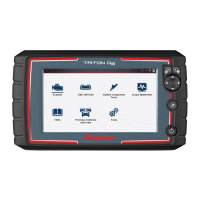Scope Multimeter Overview
98
12.2.2 Graphing Multimeter (GMM)
Unlike the DMM, the graphing multimeter provides two channels for testing and
plots a visual graphing line of the signal instead of displaying digital values. The
GMM displays a signal’s measurements over time on a two-dimensional grid. This
plotted graph is basically a graphical history (histogram) of the signal’s
measurements over time.
The GMM uses a higher sample rate (than a DMM) to calculate signal
measurements. This characteristic along with the visual graph, make the GMM
ideal for finding intermittent dropouts or glitches that may not be obvious when
viewing a digital value. A key advantage of the GMM is being able to capture a
signal over a long time interval and then review it’s graphical history, to visually see
if and when dropouts have occurred.
In addition, the GMM uses a combination of filter and peak detect modes to provide
a good balance between detecting fast glitches and preventing unwanted noise
from displaying.
Unlike the lab scope, the sweep scales used with typical GMM tests are of longer
time intervals, and may range from seconds to minutes, compared to the lab scope
sweep scales that use relatively short time intervals (e.g. milli and micro seconds).
This allows you to monitor a signal over a longer period of time when looking for
erratic glitches or dropouts.
To use the GMM, select the Scope Multimeter icon from the home screen then
select Graphing Multimeter from the menu. See Tests and Capabilities (Quick
Reference) on page 100 for a list of available testing functions.
Specifications
Function Range Accuracy/Comments
Signal
Measurement
Ch. 1— (yellow jack)
Ch. 2— (green jack)
Each channel input is
referenced to common ground
(GND— black jack)
Sample Rate 1.5 MSPS
Continuous sampling,
MSPS = mega samples per
second
Band Width 3 MHz 3 db point @ 3 MHz
Input Impedance
10 MΩ @ DC
4 kΩ @ 3 MHz
Channel 1 and 2
VDC (Full Scale) 75VDC
Do not measure greater than
75VDC
VAC (Full Scale) 50VAC
Do not measure greater than
50 VAC (rms)
Ohm Measurement
Diode Test
Continuity Test
Ch. 1— (yellow jack (–))
Ch. 2— (green jack (+))
-
Ohms 40 Ω—4 MΩ Fixed scales
Low Amp Probe
20A scale (100mV/Amp)
40A scale (10mV/Amp)
60A scale (10mV/Amp)
Connect the positive (+) Amp
Probe lead to the yellow jack
on the diagnostic tool for
values on Ch.1, or to the green
jack for values on Ch. 2.
Connect the negative (–) lead
to GND (black jack)
1
.
1. Do not use the Low Amp Probe to measure current on conductors at a potential greater than
46VAC peak or 70VDC.

